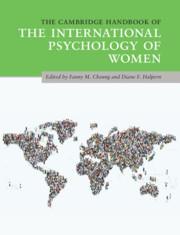Book contents
- The Cambridge Handbook of the International Psychology of Women
- The Cambridge Handbook of the International Psychology of Women
- Copyright page
- Dedication
- Contents
- Figures
- Tables
- Contributors
- Acknowledgments
- Section 1 The Underpinnings of Sex and Gender and How to Study Them
- Section 2 Developmental Perspectives of the International Psychology of Women
- Section 3 Cognitive and Social Factors
- Section 4 Work and Family Issues
- Section 5 Inequality and Social Justice
- Section 6 Health and Well-Being
- 31 Happiness across Cultures and Genders
- 32 Women under Pressure
- 33 Gender and Women’s Sexual and Reproductive Health
- 34 Physical Health
- 35 Women and Suicidal Behavior
- 36 Sex and Gender in Psychopathology
- 37 Women and Psychotherapy
- Epilogue Some Final Thoughts and Take-Home Messages
- Index
- References
33 - Gender and Women’s Sexual and Reproductive Health
from Section 6 - Health and Well-Being
Published online by Cambridge University Press: 20 July 2020
- The Cambridge Handbook of the International Psychology of Women
- The Cambridge Handbook of the International Psychology of Women
- Copyright page
- Dedication
- Contents
- Figures
- Tables
- Contributors
- Acknowledgments
- Section 1 The Underpinnings of Sex and Gender and How to Study Them
- Section 2 Developmental Perspectives of the International Psychology of Women
- Section 3 Cognitive and Social Factors
- Section 4 Work and Family Issues
- Section 5 Inequality and Social Justice
- Section 6 Health and Well-Being
- 31 Happiness across Cultures and Genders
- 32 Women under Pressure
- 33 Gender and Women’s Sexual and Reproductive Health
- 34 Physical Health
- 35 Women and Suicidal Behavior
- 36 Sex and Gender in Psychopathology
- 37 Women and Psychotherapy
- Epilogue Some Final Thoughts and Take-Home Messages
- Index
- References
Summary
This chapter focuses on women’s sexual and reproductive health across their lifecourse. It begins with an overview of how sexual and reproductive health has been defined historically and today. Next, it describes the leading causes of morbidity and mortality related to sexual and reproductive health globally and then turns to some specific health outcomes that primarily or exclusively impact girls and younger women, and women during their childbearing ages, as well as peri- and post-menopausal women. The chapter highlights some of the ways gender adversely impacts girls’ and women’s sexual and reproductive health and rights as well as how gendered opportunities limit women’s access to sexual and reproductive health care and services. The chapter concludes with a summary and recommendations for future research and programs.
Keywords
- Type
- Chapter
- Information
- The Cambridge Handbook of the International Psychology of Women , pp. 472 - 482Publisher: Cambridge University PressPrint publication year: 2020
References
Suggested Readings

Michelle J. Hindin is director of the Population Council’s Reproductive Health Program. Prior to joining she was Professor, Department of Population, Family, and Reproductive Health at the Johns Hopkins Bloomberg School of Public Health, where she continues to hold an adjunct appointment. She was also a scientist in WHO’s Reproductive Health and Research Department. She has published more than 115 peer-reviewed articles on topics ranging from contraceptive use to women’s empowerment. Hindin was born in the USA. She earned her PhD in Sociology at Johns Hopkins University and an MHS in the Department of Population Dynamics at the Johns Hopkins School of Hygiene and Public Health. She spent a semester in Brazil during her college years and did her doctoral research in Zimbabwe. She had a three-month consultancy in Rwanda, and worked extensively in a number of countries in sub-Saharan Africa.

Funmilola OlaOlorun is a Nigerian-born and trained community health physician. She grew up in both Nigeria and the United States. She has a PhD from the Department of Population, Family and Reproductive Health at the Johns Hopkins Bloomberg School of Public Health, Baltimore, MD. OlaOlorun is currently a Senior Lecturer in the Department of Community Medicine, College of Medicine, University of Ibadan, and an Honourary Consultant to the University College Hospital, Ibadan, Nigeria. Her main research interest is in women’s health across the life course, with a special focus on women’s empowerment and their reproductive health issues, especially family planning. OlaOlorun is also interested in gender-related issues, such as intimate-partner violence and how its experience influences the health and lives of women. She hopes that her career of teaching, research, and clinical practice helps to improve the health of Nigerian women and men, as well as the communities from which they come.



